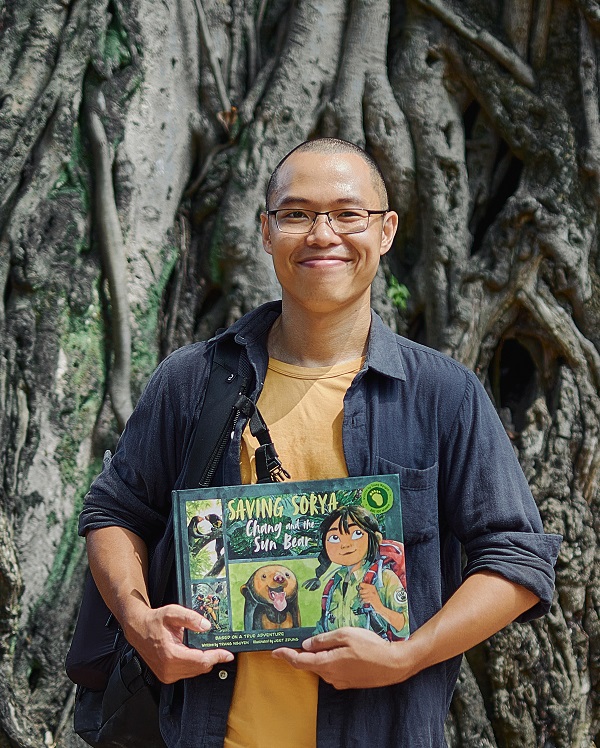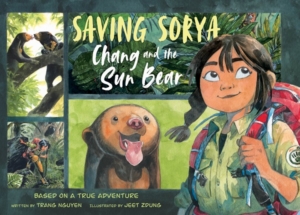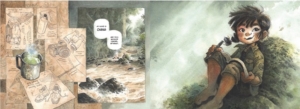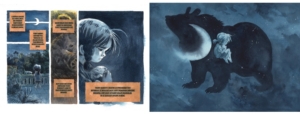
An interview with Jeet Zdung, winner of the 2023 Yoto Carnegie Medal for Illustration
 This year’s Yoto Carnegie Medal for Illustration has been awarded to Jeet Zdung for Saving Sorya: Chang & the Sun Bear, a beautiful and empowering book with a strong message about conservation. Jeet Zdung grew up in and still lives in Hanoi, Vietnam. He uses diverse drawing styles, from realistic depictions to cartoon, manga, and Vietnamese-Japanese folk styles, to create multiform works for readers of all ages. He has won several awards, including a Silent Manga Audition Excellence Award for his manga Stand Up and Fly.
This year’s Yoto Carnegie Medal for Illustration has been awarded to Jeet Zdung for Saving Sorya: Chang & the Sun Bear, a beautiful and empowering book with a strong message about conservation. Jeet Zdung grew up in and still lives in Hanoi, Vietnam. He uses diverse drawing styles, from realistic depictions to cartoon, manga, and Vietnamese-Japanese folk styles, to create multiform works for readers of all ages. He has won several awards, including a Silent Manga Audition Excellence Award for his manga Stand Up and Fly.
Tanja Jennings, one of the judges on this year’s Yoto Carnegies panel, interviewed Jeet for Books for Keeps.
Welcome to Books for Keeps, Jeet. Congratulations on winning the Carnegie Medal for Illustration.
Can you tell us about your visit to the bear rescue centre in Vietnam. How long did you spend researching bears for your portrayal of Sun Bear Sorya through her different ages?
I didn’t have much time to research the bears for the book, and I only had about a week to observe Sorya at the Free the Bears rescue centre. Sorya was older then, so I created an image of her as a bear cub based on pictures of the other bear cubs and from stories the experts and employees at Free the Bears shared.
How did you connect with the emotions of your characters?
It’s a bit difficult to explain, but my characters live, feel and enter the adventures in their world, and all that appears in my mind like a movie. Over the course of two years my connection with the characters and their emotions became very strong, and in that time I was able to follow and observe them, grabbing moments which I then drew on to paper.
The book deals with some very distressing themes. Which double page spread was the most difficult to draw for you?
When I began work on Saving Sorya, a lot of things were new to me. I had never created a book of this size or used so much watercolour and so it was all very difficult for me technically. Everything happens in my mind like a movie, and I have to capture the moment and draw it quickly and continuously so that I can convey emotion on the page. The scene of Chang saying goodbye to Sorya is an example of this.
The landscape, flora and fauna of the rainforest is depicted beautifully throughout. Do you have a special place that inspired it? Can you tell us about it?
The biggest inspiration is Nam Cat Tien National Park in southern Vietnam. It is a large tropical forest with a variety of terrain and lots of noises – the sound of the apes woke me up in the morning, as well as the numerous birds, insects and amphibians. I am someone who likes quiet, but the noise in Nam Cat Tien didn’t bother me at all.
For many people, just wandering in the forest and observing trees can be quite boring, but Nam Cat Tien was like being at an exhibition for me. The plants there are the most magical types of artwork; artwork I can touch, smell and climb up.
You have a series of pages depicting endangered habitats as Chang searches for a safe place for Sorya. What were your decisions behind the layout and use of panels on these?
I want the reader to feel the same emotions as the characters and the way to do this is to divide the layout and frames to create a rhythm for the readers. With many small and narrow frames side by side on the page, it becomes more tense and feels more intense. A large and wide scene then slows down the tempo. This is the common technique of the manga creator.
What materials did you use to create your art?
I use pencils, brushes, watercolours, ink, and watercolour paper.
Can you choose a favourite illustration and talk us through your creative process?
Storyboards need to be created to lead the emotional rhythm through events and moments, so perhaps choosing a moment rather than an illustration would be best to demonstrate the process. The scene where Chang said goodbye to Sorya was very emotional. I divided the frames so that the reader can see the way the characters look at each other and their feelings, but this wouldn’t have worked without the context of their relationship earlier in the story. There are moments which show Chang’s joy at seeing Sorya becoming independent, and then the anxiety and fear of losing Sorya; the overwhelming joy of seeing Sorya befriend another bear, then the moment that shows Chang silently observing Sorya before saying goodnight. My process is to draw over and over again until I can get across what the story requires.
What gave you the idea to fuse expressive manga with nature diary style notes and observations?
It was based on personal preferences and a style I’ve really enjoyed creating since I was a kid, like a manga movie on paper. I also love creating wildlife books for myself, and when I watch documentaries I like to take notes and draw as much as possible. By illustrating Saving Sorya, I’ve had the opportunity to do a lot of things I’ve loved doing since I was a kid. The style of drawing and taking notes in Chang’s nature diary was greatly inspired by artist Dao Van Hoang. He’s an artist I admire a lot and his nature notebooks are truly stunning.
What appeals to you about the comic book format?
I like to make my own movies, and comics and manga are the most convenient way for me to do that. My paintings are no longer pictures, they are scenes, moments, episodes, time, rhythms, atmospheres, emotions, and the characters breathe and have personalities and habits, which I find readers empathise with.
What inspired your choice of colour palette?
It was the natural scenery in Nam Cat Tien National Park. I did my best to make the colours in the book as realistic as possible.
Saving Sorya: Chang & the Sun Bear by Trang Nguyen, illustrated by Jeet Zdung, Kingfisher, an imprint of Macmillan Children’s Books, 978-0753446591, £14.99hbk







